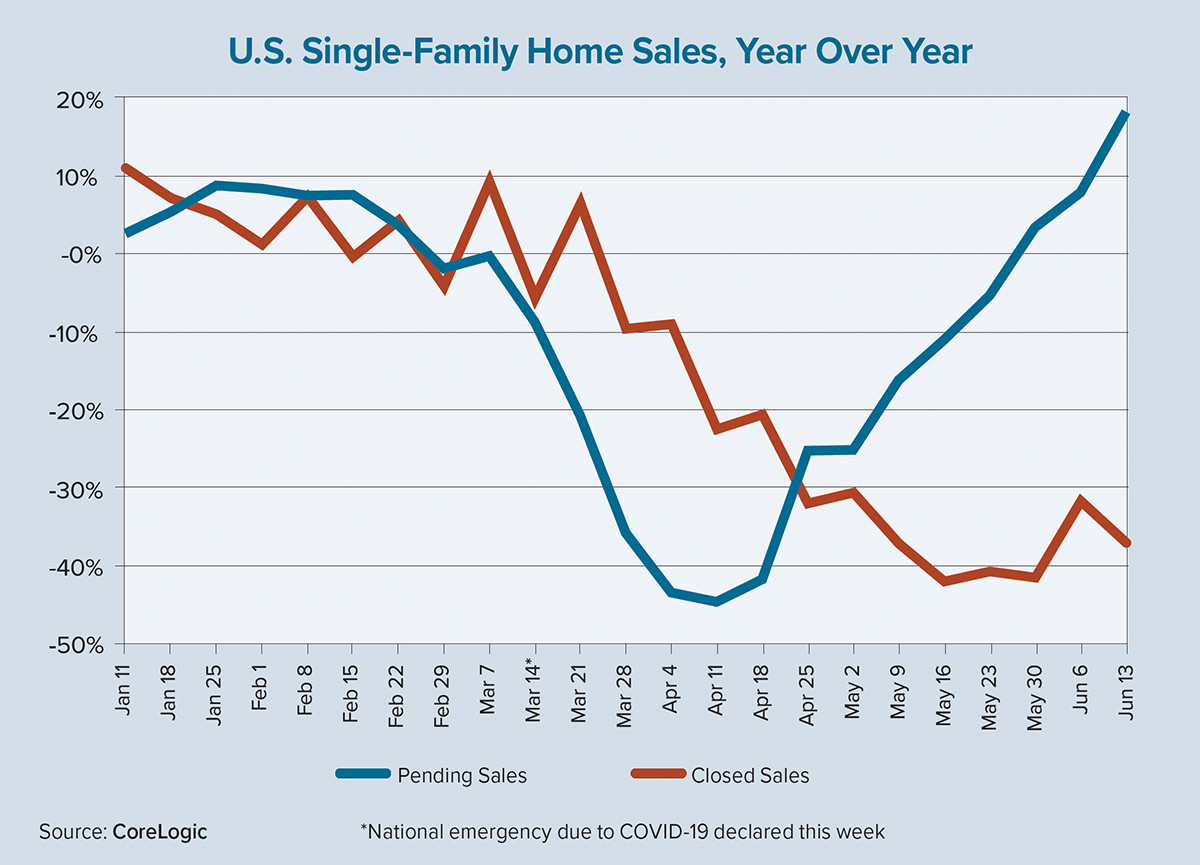The COVID-19 pandemic triggered widespread shelter-in-place orders and the declaration of a national emergency this past March. These events had significance for the mortgage and housing industries, as they led to cancellations of open houses and withdrawals of for-sale properties through multiple listing services (MLS). The pandemic also short-circuited the typical ramp-up by prospective homebuyers and sellers during the early portions of the spring buying season.
Given the dire circumstances that led to sales drying up, the turnaround for the market since its April 2020 trough has been remarkable. Sales and new-construction activities have rebounded, and the housing industry is well-positioned to be the sector that leads the U.S. macroeconomic recovery efforts.
Although settlements on existing-home sales transactions fell through this past May, contract signings (also known as pending sales) provide a preview of what to expect in the coming weeks. Typically, the time between contract ratification and closing is 30 to 45 days. Using CoreLogic weekly data on MLS activity, pending sales fell sharply after the national emergency was declared. On a year-over-year basis, pending sales troughed in mid-to-late April 2020. But pending sales rebounded and exceeded their levels of a year earlier by late May.
A driving force behind the pickup in pending sales was first-time homebuyers, a demographic largely comprised of millennials. Attracted by record-low mortgage rates this past May — which averaged 3.23% for 30-year fixed-rate loans, 84 basis points lower than in May 2019, according to Freddie Mac — the monthly principal and interest payment to purchase the typical starter home was lower than a year ago.
First-time buyers have been active since the start of the year, pushing up the U.S. homeownership rate to 65.3% as of first-quarter 2020, which matched the highest seasonally unadjusted figure recorded since fourth-quarter 2012, according to census figures. Repeat homebuyers, who are typically older homeowners with higher risks of contracting COVID-19 and often have flexibility in timing their purchases, were returning to the market, too, albeit at reduced levels from a year earlier.
One drag on home sales continues to be the lean inventory of for-sale inventory. As the pandemic spread, open houses were cancelled, listings were withdrawn and new offerings were postponed. New listings have picked up after bottoming out this past April, while many withdrawn listings have returned. Nonetheless, for-sale inventory in June 2020 remained below the level of 12 months earlier.
With buyer demand returning alongside a limited supply of for-sale homes, upward pressure on prices was likely to continue throughout this summer. The longer-term outlook for home prices is less sanguine: If unemployment remains elevated through spring 2021 and buyer activity weakens, then home prices are likely to dip in hard-hit markets.
CoreLogic’s April 2020 home-price index report predicted 12-month price declines of 4% or more in Nevada, Florida and Louisiana. And the CoreLogic market-risk indicator, a monthly measurement of the overall health of the U.S. housing market, predicted a high probability (greater than 60%) of home-price declines by April 2021 in the metro areas of Prescott, Arizona; Huntington, West Virginia; Cape Coral-Fort Myers, Florida; and College Station-Bryan, Texas.
Nationally, expect to see a home-price decline of 1.3% by April 2021. This would represent the first annualized price decrease in more than nine years, and it’s a sharp pullback from the 5.4% growth between April 2019 and April 2020.
Historically low interest rates and the relaxing of shelter-in-place directives has converted the dire spring season into a summer buying spree. The housing and mortgage industries may well be among the first major sectors of the economy to see an upswing. This could help to pull the rest of the U.S. macroeconomy into an expansion during the second half of 2020. ●
Author
-

Frank E. Nothaft is chief economist for CoreLogic, America’s largest provider of advanced property and ownership information, analytics and data-enabled services. He leads the economics team responsible for analysis, commentary and forecasting trends in global real estate, insurance and mortgage markets. Before joining CoreLogic, Nothaft served as chief economist for Freddie Mac. Prior to Freddie Mac, he was an economist with the Board of Governors of the Federal Reserve System.





